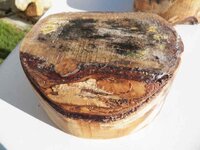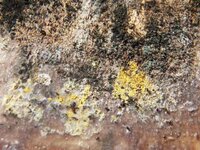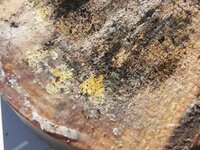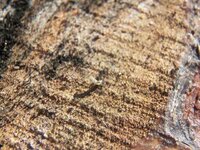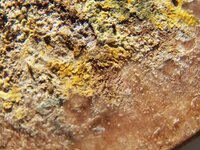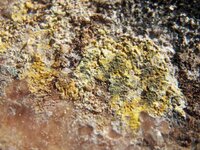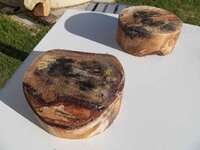robutacion
Member
Hi folks...!
I don't think that will be necessary to explain/define wood spalting and all the various fungi that develop in green/wet wood, as we all, the one way of the other, have dealt with it.
While some turners would not touch any woods that show any signs of spalting or fungi presence, others will give their preference to any woods that have as much spalting as possible. Is also true that, "most" trees a good candidates for natural spalting, particularly after the trees have been cut down and left on the moist ground for a short period of time, there some turners out there that go to great extents to provoke extreme spalting in woods that they have store, being a few ways to achieve that.
However, the reason of this thread, is to show to all of you people, some work I've done a few days ago on some Pepper Corn blanks that I have cut and processed (cut to size and wax on the end grain) and put to dry in my drying shelves.
The tree was very green and the blanks I processed were done so, the day after I cut the Pepper tree down so, the wood was very green and very wet.
This is the same process I take for all green timbers so that I dispose (next year's firewood) of the left overs, making the blanks dry faster and take a lot less space than having the logs stored.
This was the first time I worked with this type of wood and I could see that the wood was full of sap and a white/milkish colour liquid, coming out of the chainsaw cuts. The square and round blanks were stored on top of each other, without any "separators" which I should have used, as the wood was very wet but I din't thing that would be critical to the wood preservation and drying.
A couple of days ago I had someone asking me if I had any round blanks from the Pepper Corn tree wood, which I answered "informative" but need to measure them up to confirm sizes suitability. This was when I notice a lot of fungi in between blanks (where they were in contact to each other), even tough the blanks had been waxed all around and up to 1" 1/2 on the flat faces, leaving a relatively small area of raw/un-waxed wood so that the moisture could come out from.
I had my heavy duty working glasses on, so I could see these very small little bugs moving within the areas with the fungi so, and curious about how they would look like zoomed out, I got my digital camera and zoomed in a far as I could and took some pics. In them, is perfectly visible a number of different creature species moving around so I though in take one of the blanks to the house, and use my USB Microscope up to 200 x Zoom, as I new that I could record a video of the movement, making it a lot more real and natural.
So I did and the result was a small video about 3.5 minutes which I don't seem to be able to download on YouTube, for whatever reason but I could use my account with Photobucket to download it into for public viewing, If I manage to provide the correct link...!
So, here they are, a few pics and then the video...! enjoy.
PS: I didn't put any sound (music) on the video clip...!:frown:
[URL=http://smg.photobucket.com/albums/v611/jorgesmaximus/The%20Videos%20place/?action=view¤t=Woodspaltingcreaturesatwork.mp4] [/URL]
[/URL]
Cheers
George
I don't think that will be necessary to explain/define wood spalting and all the various fungi that develop in green/wet wood, as we all, the one way of the other, have dealt with it.
While some turners would not touch any woods that show any signs of spalting or fungi presence, others will give their preference to any woods that have as much spalting as possible. Is also true that, "most" trees a good candidates for natural spalting, particularly after the trees have been cut down and left on the moist ground for a short period of time, there some turners out there that go to great extents to provoke extreme spalting in woods that they have store, being a few ways to achieve that.
However, the reason of this thread, is to show to all of you people, some work I've done a few days ago on some Pepper Corn blanks that I have cut and processed (cut to size and wax on the end grain) and put to dry in my drying shelves.
The tree was very green and the blanks I processed were done so, the day after I cut the Pepper tree down so, the wood was very green and very wet.
This is the same process I take for all green timbers so that I dispose (next year's firewood) of the left overs, making the blanks dry faster and take a lot less space than having the logs stored.
This was the first time I worked with this type of wood and I could see that the wood was full of sap and a white/milkish colour liquid, coming out of the chainsaw cuts. The square and round blanks were stored on top of each other, without any "separators" which I should have used, as the wood was very wet but I din't thing that would be critical to the wood preservation and drying.
A couple of days ago I had someone asking me if I had any round blanks from the Pepper Corn tree wood, which I answered "informative" but need to measure them up to confirm sizes suitability. This was when I notice a lot of fungi in between blanks (where they were in contact to each other), even tough the blanks had been waxed all around and up to 1" 1/2 on the flat faces, leaving a relatively small area of raw/un-waxed wood so that the moisture could come out from.
I had my heavy duty working glasses on, so I could see these very small little bugs moving within the areas with the fungi so, and curious about how they would look like zoomed out, I got my digital camera and zoomed in a far as I could and took some pics. In them, is perfectly visible a number of different creature species moving around so I though in take one of the blanks to the house, and use my USB Microscope up to 200 x Zoom, as I new that I could record a video of the movement, making it a lot more real and natural.
So I did and the result was a small video about 3.5 minutes which I don't seem to be able to download on YouTube, for whatever reason but I could use my account with Photobucket to download it into for public viewing, If I manage to provide the correct link...!
So, here they are, a few pics and then the video...! enjoy.
PS: I didn't put any sound (music) on the video clip...!:frown:
[URL=http://smg.photobucket.com/albums/v611/jorgesmaximus/The%20Videos%20place/?action=view¤t=Woodspaltingcreaturesatwork.mp4]
 [/URL]
[/URL]Cheers
George

